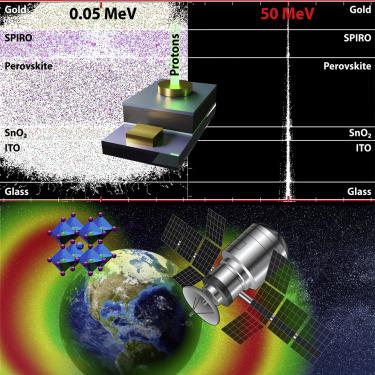Joule ( IF 38.6 ) Pub Date : 2022-04-11 , DOI: 10.1016/j.joule.2022.03.004 Ahmad R. Kirmani 1 , Brandon K. Durant 2 , Jonathan Grandidier 3, 4 , Nancy M. Haegel 1 , Michael D. Kelzenberg 4 , Yao M. Lao 5 , Michael D. McGehee 6 , Lyndsey McMillon-Brown 7 , David P. Ostrowski 1 , Timothy J. Peshek 7 , Bibhudutta Rout 8 , Ian R. Sellers 2 , Mark Steger 1 , Don Walker 5 , David M. Wilt 9 , Kaitlyn T. VanSant 1, 7 , Joseph M. Luther 1

|
Perovskite photovoltaics (PVs) are under intensive development for promise in terrestrial energy production. Soon, the community will find out how much of that promise may become reality. Perovskites also open new opportunities for lower cost space power. However, radiation tolerance of space environments requires appropriate analysis of relevant devices irradiated under representative radiation conditions. We present guidelines designed to rigorously test the radiation tolerance of perovskite PVs. We review radiation conditions in common orbits, calculate nonionizing and ionizing energy losses (NIEL and IEL) for perovskites, and prioritize proton radiation for effective nuclear interactions. Low-energy protons (0.05–0.15 MeV) create a representative uniform damage profile, whereas higher energy protons (commonly used in ground-based evaluation) require significantly higher fluence to accumulate the equivalent displacement damage dose due to lower scattering probability. Furthermore, high-energy protons may “heal” devices through increased electronic ionization. These procedural guidelines differ from those used to test conventional semiconductors.
中文翻译:

钙钛矿太空发射倒计时:进行相关辐射硬度实验的指南
钙钛矿光伏 (PV) 正在密集开发中,有望用于陆地能源生产。很快,社区就会发现有多少承诺可能会成为现实。钙钛矿还为低成本太空能源开辟了新机遇。然而,空间环境的辐射耐受性需要对在代表性辐射条件下辐照的相关设备进行适当的分析。我们提出了旨在严格测试钙钛矿 PV 辐射耐受性的指南。我们回顾了普通轨道上的辐射条件,计算钙钛矿的非电离和电离能量损失(NIEL 和 IEL),并优先考虑质子辐射以实现有效的核相互作用。低能质子 (0.05–0.15 MeV) 产生具有代表性的均匀损伤分布,而较高能量的质子(通常用于地面评估)由于散射概率较低,因此需要显着较高的能量密度来累积等效位移损伤剂量。此外,高能质子可以通过增加电子电离来“治愈”设备。这些程序指南不同于用于测试传统半导体的程序指南。











































 京公网安备 11010802027423号
京公网安备 11010802027423号